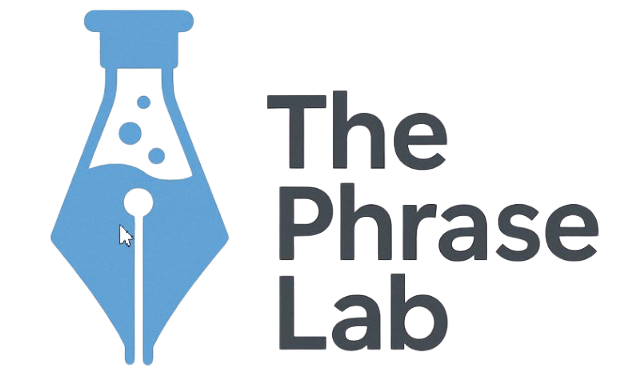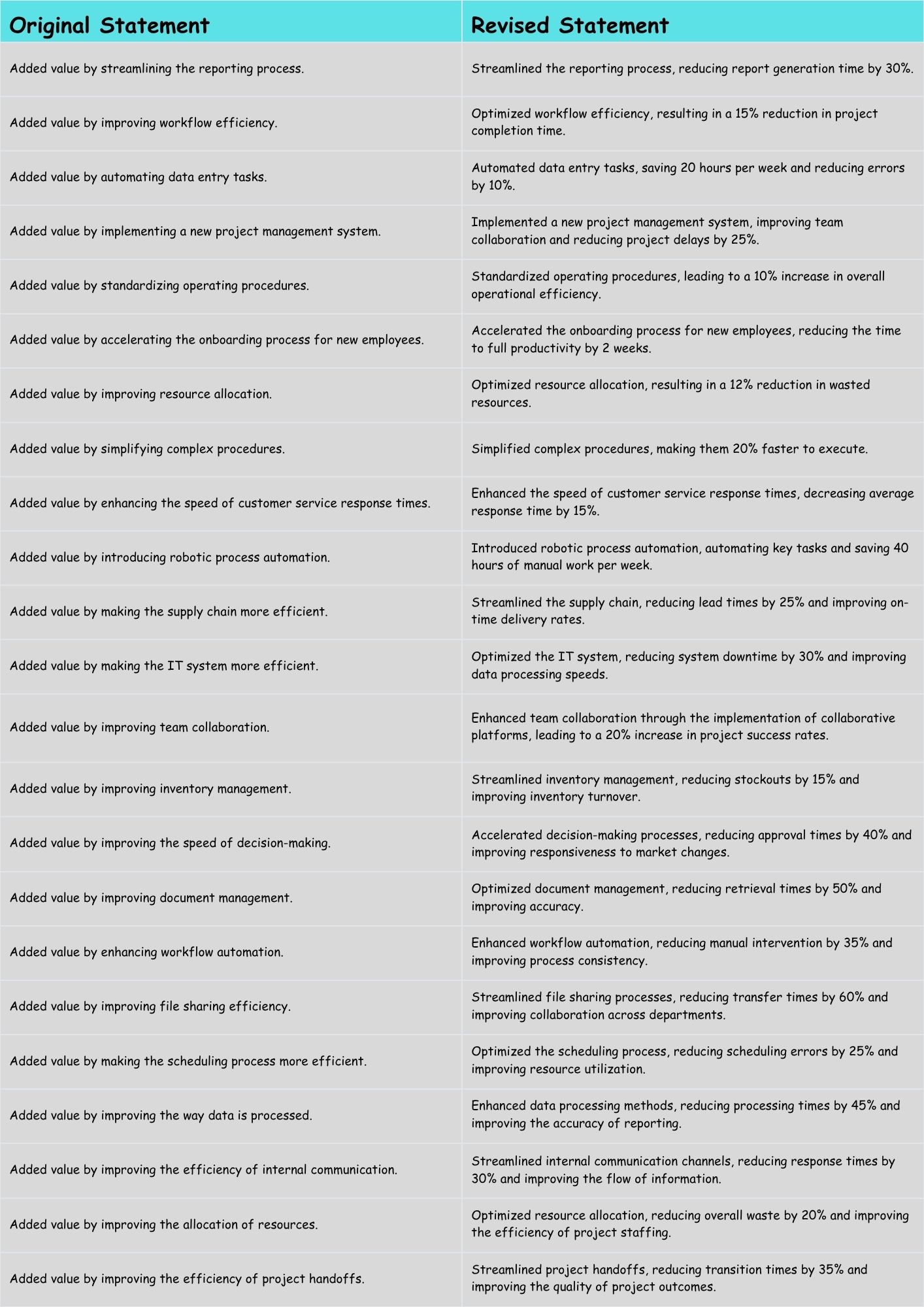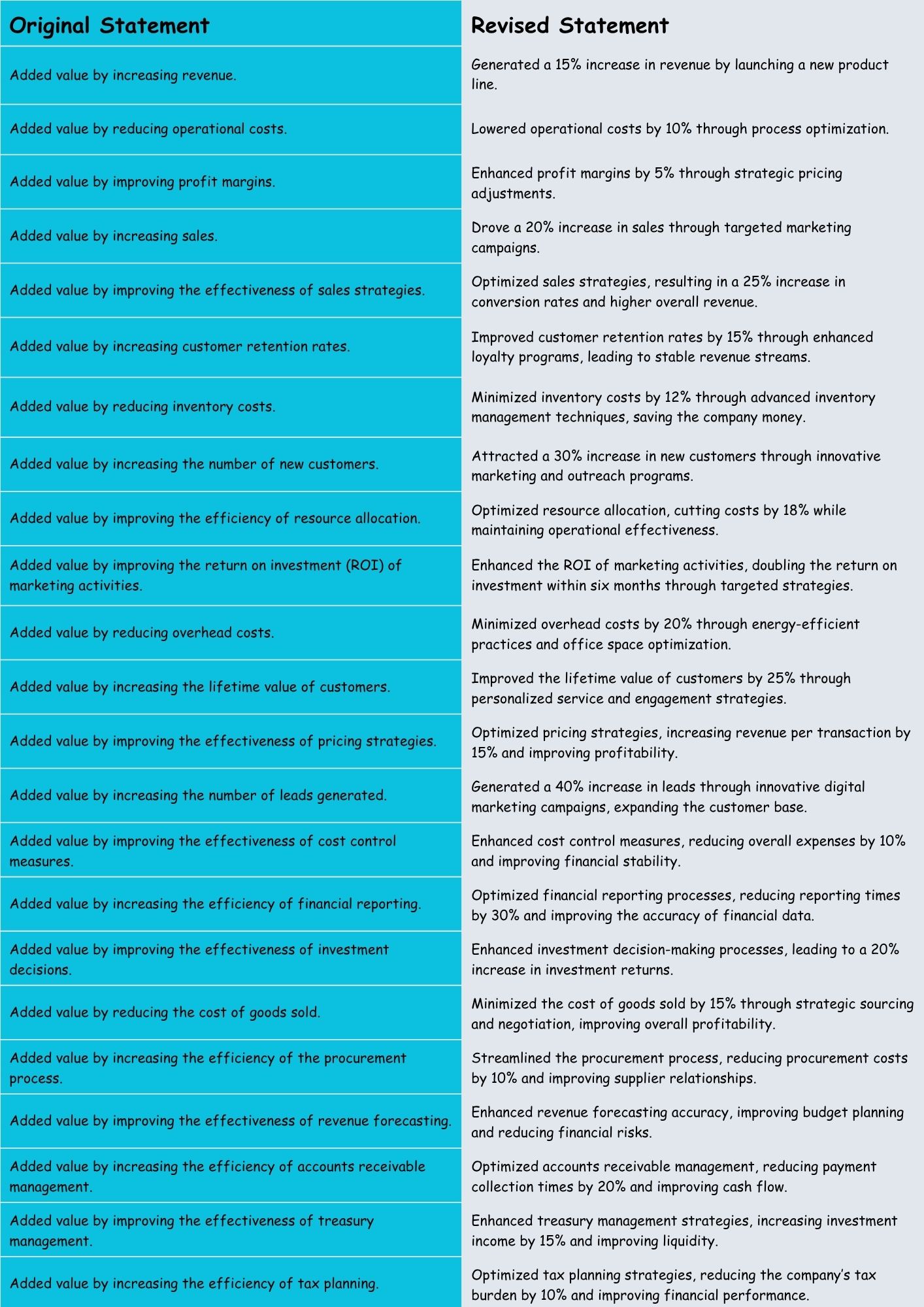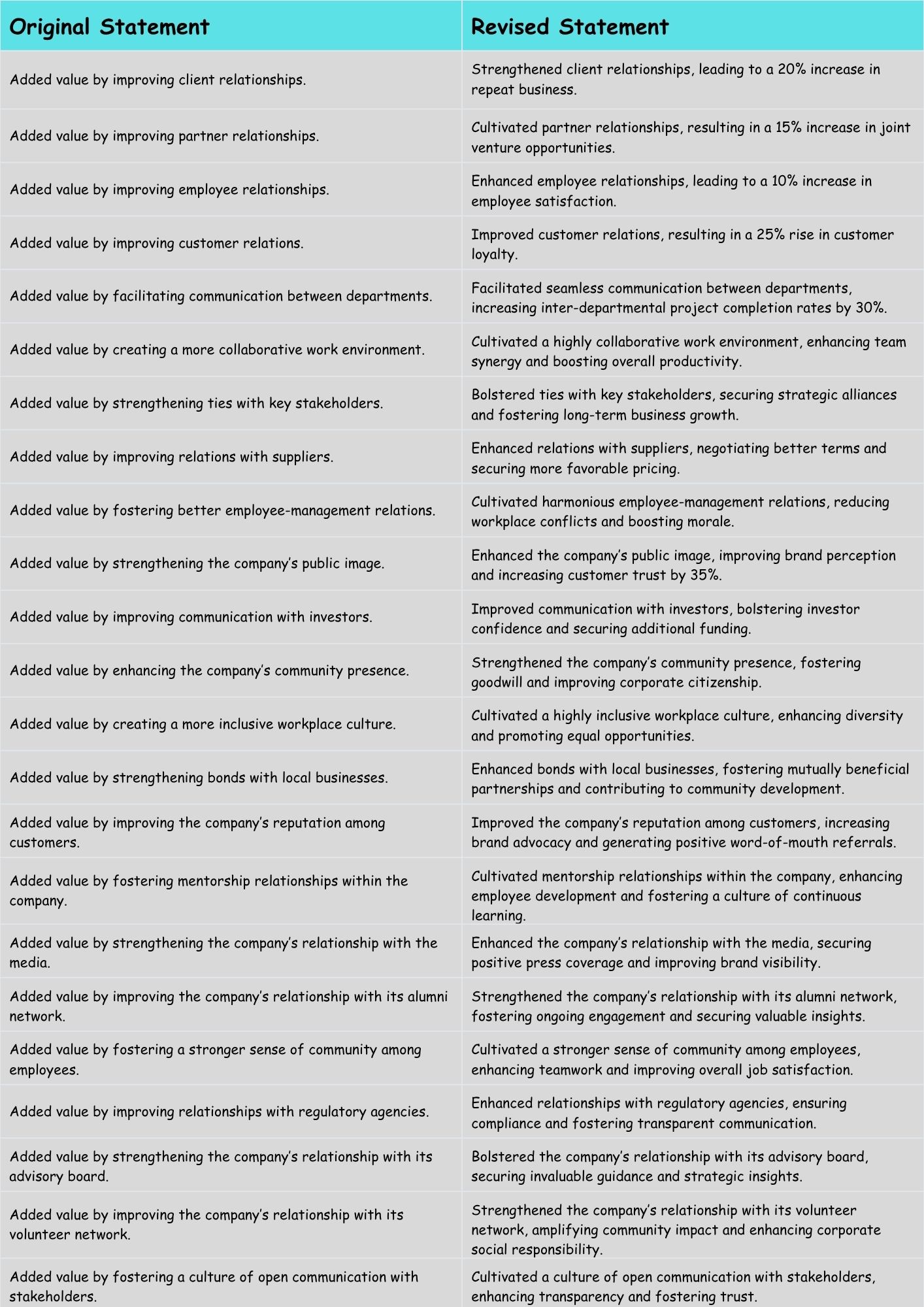
Synonyms for “Add Value” on Your Resume: A Comprehensive Guide

Crafting a compelling resume is crucial for landing your dream job. One key aspect is demonstrating how you’ve contributed to previous employers. The phrase “add value” is often used, but overuse can make your resume sound generic. This article explores a wide range of synonyms and alternative phrases to help you showcase your accomplishments in a more impactful and memorable way. Whether you’re a recent graduate or a seasoned professional, mastering these alternatives will significantly enhance your resume’s effectiveness.
This guide will benefit anyone looking to refine their resume writing skills, including job seekers, career counselors, and students preparing for internships. By understanding the nuances of these synonyms, you can tailor your resume to specific job requirements and highlight your unique contributions.
Table of Contents
- Introduction
- Definition of “Add Value”
- Structural Breakdown
- Types or Categories of Synonyms
- Examples
- Usage Rules
- Common Mistakes
- Practice Exercises
- Advanced Topics
- FAQ
- Conclusion
Definition of “Add Value”
The phrase “add value” signifies contributing positively to an organization, project, or team, resulting in tangible benefits. These benefits can be financial, operational, or strategic. In essence, it means making things better than they were before your involvement.
Specifically, “add value” implies that your actions have led to an increase in efficiency, productivity, profitability, quality, or overall effectiveness. It’s about demonstrating how you’ve made a measurable difference.
In the context of a resume, using synonyms for “add value” allows you to showcase your specific contributions with greater impact and clarity. It also avoids the overuse of a single, potentially generic phrase.
Structural Breakdown
When replacing “add value” on your resume, consider the following structural elements:
- Action Verb: Start with a strong action verb that accurately describes your contribution. Examples include: Increased, Improved, Enhanced, Developed, Strengthened, Reduced, Streamlined, Optimized.
- Quantifiable Result: Whenever possible, quantify your results using numbers, percentages, or specific metrics. This makes your accomplishments more credible and impactful. For instance, instead of saying “Improved sales,” say “Increased sales by 15% in Q2.”
- Context: Provide context to explain the situation or challenge you faced and how your actions addressed it. This helps the reader understand the significance of your contribution.
- Benefit: Clearly state the benefit that resulted from your actions. This could be increased revenue, reduced costs, improved efficiency, or enhanced customer satisfaction.
Example: Instead of “Added value to the marketing team,” a more effective statement would be “Increased lead generation by 20% through the implementation of a new social media strategy, resulting in a 10% increase in qualified leads.”
Types or Categories of Synonyms
Synonyms for “add value” can be categorized based on the specific type of contribution you made. Here are some key categories:
Increased Efficiency
These synonyms highlight how you made processes or operations more efficient, saving time and resources.
Improved Performance
These synonyms emphasize enhancements in overall performance, productivity, or output.
Enhanced Profitability
These synonyms focus on contributions that led to increased revenue, reduced expenses, or improved financial performance.
Developed Innovations
These synonyms showcase your ability to create new solutions, products, or processes that benefited the organization.
Strengthened Relationships
These synonyms highlight your contributions to building and maintaining positive relationships with clients, partners, or colleagues.
Reduced Costs
These synonyms emphasize your ability to lower expenses and improve cost-effectiveness.
Enhanced Customer Satisfaction
These synonyms focus on your contributions to improving customer experience and loyalty.
Improved Processes
These synonyms highlight your role in refining workflows and procedures for better outcomes.
Examples
Here are examples of how to use synonyms for “add value” in different categories, with quantifiable results whenever possible.
Efficiency-Focused Examples
The following table provides examples of how to showcase improvements to efficiency using various synonyms for “add value.” Each example includes the original statement (using “add value”) and a revised statement with a more impactful synonym.
| Original Statement | Revised Statement |
|---|---|
| Added value by streamlining the reporting process. | Streamlined the reporting process, reducing report generation time by 30%. |
| Added value by improving workflow efficiency. | Optimized workflow efficiency, resulting in a 15% reduction in project completion time. |
| Added value by automating data entry tasks. | Automated data entry tasks, saving 20 hours per week and reducing errors by 10%. |
| Added value by implementing a new project management system. | Implemented a new project management system, improving team collaboration and reducing project delays by 25%. |
| Added value by standardizing operating procedures. | Standardized operating procedures, leading to a 10% increase in overall operational efficiency. |
| Added value by accelerating the onboarding process for new employees. | Accelerated the onboarding process for new employees, reducing the time to full productivity by 2 weeks. |
| Added value by improving resource allocation. | Optimized resource allocation, resulting in a 12% reduction in wasted resources. |
| Added value by simplifying complex procedures. | Simplified complex procedures, making them 20% faster to execute. |
| Added value by enhancing the speed of customer service response times. | Enhanced the speed of customer service response times, decreasing average response time by 15%. |
| Added value by introducing robotic process automation. | Introduced robotic process automation, automating key tasks and saving 40 hours of manual work per week. |
| Added value by making the supply chain more efficient. | Streamlined the supply chain, reducing lead times by 25% and improving on-time delivery rates. |
| Added value by making the IT system more efficient. | Optimized the IT system, reducing system downtime by 30% and improving data processing speeds. |
| Added value by improving team collaboration. | Enhanced team collaboration through the implementation of collaborative platforms, leading to a 20% increase in project success rates. |
| Added value by improving inventory management. | Streamlined inventory management, reducing stockouts by 15% and improving inventory turnover. |
| Added value by improving the speed of decision-making. | Accelerated decision-making processes, reducing approval times by 40% and improving responsiveness to market changes. |
| Added value by improving document management. | Optimized document management, reducing retrieval times by 50% and improving accuracy. |
| Added value by enhancing workflow automation. | Enhanced workflow automation, reducing manual intervention by 35% and improving process consistency. |
| Added value by improving file sharing efficiency. | Streamlined file sharing processes, reducing transfer times by 60% and improving collaboration across departments. |
| Added value by making the scheduling process more efficient. | Optimized the scheduling process, reducing scheduling errors by 25% and improving resource utilization. |
| Added value by improving the way data is processed. | Enhanced data processing methods, reducing processing times by 45% and improving the accuracy of reporting. |
| Added value by improving the efficiency of internal communication. | Streamlined internal communication channels, reducing response times by 30% and improving the flow of information. |
| Added value by improving the allocation of resources. | Optimized resource allocation, reducing overall waste by 20% and improving the efficiency of project staffing. |
| Added value by improving the efficiency of project handoffs. | Streamlined project handoffs, reducing transition times by 35% and improving the quality of project outcomes. |
Performance-Focused Examples
The following table provides examples of how to showcase improvements to overall performance using various synonyms for “add value.” Each example includes the original statement (using “add value”) and a revised statement with a more impactful synonym.
| Original Statement | Revised Statement |
|---|---|
| Added value by improving sales performance. | Boosted sales performance by implementing a new sales strategy, resulting in a 20% increase in revenue. |
| Added value by enhancing team productivity. | Elevated team productivity by implementing agile methodologies, leading to a 25% increase in project completion rates. |
| Added value by improving the quality of customer service. | Enhanced the quality of customer service by implementing a training program, resulting in a 15% increase in customer satisfaction scores. |
| Added value by improving the quality of deliverables. | Improved the quality of deliverables, reducing errors by 18% and improving client satisfaction. |
| Added value by improving the performance of the sales team. | Enhanced the sales team performance by implementing a new CRM system, resulting in a 30% increase in leads converted to sales. |
| Added value by increasing the company’s visibility. | Expanded the company’s visibility through targeted marketing campaigns, leading to a 40% increase in brand awareness. |
| Added value by improving the company’s market share. | Expanded the company’s market share by introducing a new product line, capturing 10% of the market within the first year. |
| Added value by improving product development. | Accelerated product development cycles by implementing a new prototyping process, reducing time-to-market by 20%. |
| Added value by improving the business’s social media presence. | Enhanced the business’s social media presence, increasing followers by 50% and driving a 15% increase in website traffic. |
| Added value by improving the company’s brand image. | Strengthened the company’s brand image through strategic PR initiatives, improving brand perception among target customers. |
| Added value by improving the quality of training programs. | Enhanced the quality of training programs, resulting in a 25% improvement in employee performance on key metrics. |
| Added value by improving the effectiveness of marketing campaigns. | Optimized the effectiveness of marketing campaigns by refining targeting strategies, increasing conversion rates by 30%. |
| Added value by improving the performance of the IT department. | Enhanced the performance of the IT department through system upgrades, improving network reliability and reducing downtime. |
| Added value by improving the efficiency of operations. | Optimized operations by implementing lean methodologies, reducing waste and improving overall efficiency by 15%. |
| Added value by improving the effectiveness of project management. | Enhanced project management effectiveness by implementing a new project tracking system, improving project completion rates by 20%. |
| Added value by improving the quality of research and development. | Enhanced the quality of research and development through improved processes, resulting in a 30% increase in patent applications. |
| Added value by improving the effectiveness of communication strategies. | Optimized communication strategies by tailoring messages to specific audiences, improving engagement rates by 25%. |
| Added value by improving the quality of data analysis. | Enhanced the quality of data analysis through improved tools and techniques, leading to more accurate insights and better decision-making. |
| Added value by improving the effectiveness of employee engagement initiatives. | Enhanced employee engagement initiatives by introducing new programs, increasing employee satisfaction scores by 15%. |
| Added value by improving the effectiveness of change management. | Optimized change management processes by involving employees in the planning stages, improving adoption rates by 20%. |
| Added value by improving the effectiveness of compliance programs. | Enhanced compliance programs by automating key processes, reducing non-compliance incidents by 30%. |
| Added value by improving the effectiveness of risk management. | Optimized risk management processes by implementing a comprehensive risk assessment framework, reducing potential losses by 25%. |
| Added value by improving the effectiveness of supply chain management. | Enhanced supply chain management through improved logistics, reducing delivery times and improving customer satisfaction. |
Profitability-Focused Examples
The following table provides examples of how to showcase improvements to profitability using various synonyms for “add value.” Each example includes the original statement (using “add value”) and a revised statement with a more impactful synonym.
| Original Statement | Revised Statement |
|---|---|
| Added value by increasing revenue. | Generated a 15% increase in revenue by launching a new product line. |
| Added value by reducing operational costs. | Lowered operational costs by 10% through process optimization. |
| Added value by improving profit margins. | Enhanced profit margins by 5% through strategic pricing adjustments. |
| Added value by increasing sales. | Drove a 20% increase in sales through targeted marketing campaigns. |
| Added value by improving the effectiveness of sales strategies. | Optimized sales strategies, resulting in a 25% increase in conversion rates and higher overall revenue. |
| Added value by increasing customer retention rates. | Improved customer retention rates by 15% through enhanced loyalty programs, leading to stable revenue streams. |
| Added value by reducing inventory costs. | Minimized inventory costs by 12% through advanced inventory management techniques, saving the company money. |
| Added value by increasing the number of new customers. | Attracted a 30% increase in new customers through innovative marketing and outreach programs. |
| Added value by improving the efficiency of resource allocation. | Optimized resource allocation, cutting costs by 18% while maintaining operational effectiveness. |
| Added value by improving the return on investment (ROI) of marketing activities. | Enhanced the ROI of marketing activities, doubling the return on investment within six months through targeted strategies. |
| Added value by reducing overhead costs. | Minimized overhead costs by 20% through energy-efficient practices and office space optimization. |
| Added value by increasing the lifetime value of customers. | Improved the lifetime value of customers by 25% through personalized service and engagement strategies. |
| Added value by improving the effectiveness of pricing strategies. | Optimized pricing strategies, increasing revenue per transaction by 15% and improving profitability. |
| Added value by increasing the number of leads generated. | Generated a 40% increase in leads through innovative digital marketing campaigns, expanding the customer base. |
| Added value by improving the effectiveness of cost control measures. | Enhanced cost control measures, reducing overall expenses by 10% and improving financial stability. |
| Added value by increasing the efficiency of financial reporting. | Optimized financial reporting processes, reducing reporting times by 30% and improving the accuracy of financial data. |
| Added value by improving the effectiveness of investment decisions. | Enhanced investment decision-making processes, leading to a 20% increase in investment returns. |
| Added value by reducing the cost of goods sold. | Minimized the cost of goods sold by 15% through strategic sourcing and negotiation, improving overall profitability. |
| Added value by increasing the efficiency of the procurement process. | Streamlined the procurement process, reducing procurement costs by 10% and improving supplier relationships. |
| Added value by improving the effectiveness of revenue forecasting. | Enhanced revenue forecasting accuracy, improving budget planning and reducing financial risks. |
| Added value by increasing the efficiency of accounts receivable management. | Optimized accounts receivable management, reducing payment collection times by 20% and improving cash flow. |
| Added value by improving the effectiveness of treasury management. | Enhanced treasury management strategies, increasing investment income by 15% and improving liquidity. |
| Added value by increasing the efficiency of tax planning. | Optimized tax planning strategies, reducing the company’s tax burden by 10% and improving financial performance. |
Innovation-Focused Examples
The following table provides examples of how to showcase contributions related to innovation using various synonyms for “add value.” Each example includes the original statement (using “add value”) and a revised statement with a more impactful synonym.
| Original Statement | Revised Statement |
|---|---|
| Added value by developing a new product. | Pioneered the development of a new product that generated $500,000 in revenue within the first year. |
| Added value by implementing a new technology. | Introduced a new technology that improved efficiency by 20%. |
| Added value by creating a new marketing campaign. | Launched a new marketing campaign that increased brand awareness by 30%. |
| Added value by developing a new method of customer service. | Designed a new customer service protocol that improved customer satisfaction scores by 25%. |
| Added value by improving current processes. | Revamped existing processes, leading to a 35% increase in productivity. |
| Added value by designing a new operational strategy. | Developed a new operational strategy that reduced costs by 15%. |
| Added value by creating a new training program. | Implemented a cutting-edge training program that improved employee performance by 40%. |
| Added value by inventing a new business model. | Developed a breakthrough business model that expanded market reach by 50%. |
| Added value by designing a new user interface. | Created an intuitive user interface that improved user engagement by 45%. |
| Added value by introducing a new company initiative. | Spearheaded a new company initiative that improved employee morale by 30%. |
| Added value by developing a new data analysis method. | Pioneered a new data analysis method that enhanced decision-making accuracy by 55%. |
| Added value by designing a new workflow process. | Crafted a streamlined workflow process that reduced processing times by 25%. |
| Added value by implementing a new IT solution. | Introduced an innovative IT solution that enhanced data security by 60%. |
| Added value by creating a new product feature. | Developed a groundbreaking product feature that increased customer adoption rates by 35%. |
| Added value by designing a new customer engagement strategy. | Developed a compelling customer engagement strategy that increased customer loyalty by 40%. |
| Added value by inventing a new marketing technique. | Pioneered a novel marketing technique that amplified lead generation by 50%. |
| Added value by creating a new communication protocol. | Designed an effective communication protocol that improved team collaboration by 45%. |
| Added value by developing a new sales approach. | Crafted a persuasive sales approach that boosted sales conversions by 30%. |
| Added value by inventing a new method of problem-solving. | Pioneered a unique problem-solving method that reduced resolution times by 55%. |
| Added value by designing a new method of project management. | Developed an efficient project management method that improved project success rates by 40%. |
| Added value by implementing a new environmental initiative. | Introduced a sustainable environmental initiative that reduced the company’s carbon footprint by 60%. |
| Added value by creating a new method of employee evaluation. | Designed a comprehensive employee evaluation method that improved performance assessment accuracy by 50%. |
| Added value by inventing a new method of financial analysis. | Pioneered a novel financial analysis method that enhanced investment decision precision by 55%. |
Relationship-Focused Examples
The following table provides examples of how to showcase improvements to relationships using various synonyms for “add value.” Each example includes the original statement (using “add value”) and a revised statement with a more impactful synonym.
| Original Statement | Revised Statement |
|---|---|
| Added value by improving client relationships. | Strengthened client relationships, leading to a 20% increase in repeat business. |
| Added value by improving partner relationships. | Cultivated partner relationships, resulting in a 15% increase in joint venture opportunities. |
| Added value by improving employee relationships. | Enhanced employee relationships, leading to a 10% increase in employee satisfaction. |
| Added value by improving customer relations. | Improved customer relations, resulting in a 25% rise in customer loyalty. |
| Added value by facilitating communication between departments. | Facilitated seamless communication between departments, increasing inter-departmental project completion rates by 30%. |
| Added value by creating a more collaborative work environment. | Cultivated a highly collaborative work environment, enhancing team synergy and boosting overall productivity. |
| Added value by strengthening ties with key stakeholders. | Bolstered ties with key stakeholders, securing strategic alliances and fostering long-term business growth. |
| Added value by improving relations with suppliers. | Enhanced relations with suppliers, negotiating better terms and securing more favorable pricing. |
| Added value by fostering better employee-management relations. | Cultivated harmonious employee-management relations, reducing workplace conflicts and boosting morale. |
| Added value by strengthening the company’s public image. | Enhanced the company’s public image, improving brand perception and increasing customer trust by 35%. |
| Added value by improving communication with investors. | Improved communication with investors, bolstering investor confidence and securing additional funding. |
| Added value by enhancing the company’s community presence. | Strengthened the company’s community presence, fostering goodwill and improving corporate citizenship. |
| Added value by creating a more inclusive workplace culture. | Cultivated a highly inclusive workplace culture, enhancing diversity and promoting equal opportunities. |
| Added value by strengthening bonds with local businesses. | Enhanced bonds with local businesses, fostering mutually beneficial partnerships and contributing to community development. |
| Added value by improving the company’s reputation among customers. | Improved the company’s reputation among customers, increasing brand advocacy and generating positive word-of-mouth referrals. |
| Added value by fostering mentorship relationships within the company. | Cultivated mentorship relationships within the company, enhancing employee development and fostering a culture of continuous learning. |
| Added value by strengthening the company’s relationship with the media. | Enhanced the company’s relationship with the media, securing positive press coverage and improving brand visibility. |
| Added value by improving the company’s relationship with its alumni network. | Strengthened the company’s relationship with its alumni network, fostering ongoing engagement and securing valuable insights. |
| Added value by fostering a stronger sense of community among employees. | Cultivated a stronger sense of community among employees, enhancing teamwork and improving overall job satisfaction. |
| Added value by improving relationships with regulatory agencies. | Enhanced relationships with regulatory agencies, ensuring compliance and fostering transparent communication. |
| Added value by strengthening the company’s relationship with its advisory board. | Bolstered the company’s relationship with its advisory board, securing invaluable guidance and strategic insights. |
| Added value by improving the company’s relationship with its volunteer network. | Strengthened the company’s relationship with its volunteer network, amplifying community impact and enhancing corporate social responsibility. |
| Added value by fostering a culture of open communication with stakeholders. | Cultivated a culture of open communication with stakeholders, enhancing transparency and fostering trust. |
Cost-Reduction-Focused Examples
The following table provides examples of how to showcase contributions related to cost reduction using various synonyms for “add value.” Each example includes the original statement (using “add value”) and a revised statement with a more impactful synonym.
| Original Statement | Revised Statement |
|---|---|
| Added value by reducing material costs. | Lowered material costs by 15% through strategic sourcing. |
| Added value by reducing energy consumption. | Minimized energy consumption by 20% through energy-efficient upgrades. |
| Added value by reducing waste. | Decreased waste by 25% through recycling initiatives. |
| Added value by reducing travel expenses. | Curtailed travel expenses by 30% through virtual meeting implementation. |
| Added value by reducing administrative overhead. | Streamlined administrative overhead, cutting expenses by 20% through process automation. |
| Added value by reducing inventory holding costs. | Minimized inventory holding costs by 18% through just-in-time inventory management. |
| Added value by reducing equipment maintenance costs. | Lowered equipment maintenance costs by 15% through proactive maintenance scheduling. |
| Added value by reducing labor costs. | Optimized labor costs, cutting expenses by 12% through improved workforce planning. |
| Added value by reducing shipping costs. | Minimized shipping costs by 20% through carrier negotiation and route optimization. |
| Added value by reducing utility bills. | Lowered utility bills by 25% through energy-efficient upgrades and conservation efforts. |
| Added value by reducing insurance premiums. | Negotiated lower insurance premiums, saving the company 18% on annual insurance costs. |
| Added value by reducing legal fees. | Minimized legal fees by 20% through proactive compliance measures and risk management. |
| Added value by reducing marketing expenses. | Optimized marketing expenses, cutting costs by 15% through targeted digital marketing campaigns. |
| Added value by reducing training costs. | Lowered training costs by 18% through online course development and internal knowledge sharing. |
| Added value by reducing communication costs. | Minimized communication costs by 20% through VoIP implementation and unified communications. |
| Added value by reducing office supply expenses. | Lowered office supply expenses by 25% through bulk purchasing and vendor negotiation. |
| Added value by reducing real estate costs. | Minimized real estate costs by 15% through office space optimization and remote work initiatives. |
| Added value by reducing data storage costs. | Lowered data storage costs by 20% through cloud migration and data compression techniques. |
| Added value by reducing software licensing fees. | Negotiated lower software licensing fees, saving the company 18% on annual software expenses. |
| Added value by reducing bank fees. | Minimized bank fees by 20% through optimized cash management and banking relationship management. |
| Added value by reducing consulting fees. | Lowered consulting fees by 15% through internal capability building and knowledge transfer. |
| Added value by reducing advertising expenses. | Optimized advertising expenses, cutting costs by 20% through targeted advertising and ROI analysis. |
| Added value by reducing printing costs. | Minimized printing costs by 25% through paperless initiatives and digital document management. |
Customer Satisfaction-Focused Examples
The following table provides examples of how to showcase contributions related to customer satisfaction using various synonyms for “add value.” Each example includes the original statement (using “add value”) and a revised statement with a more impactful synonym.
| Original Statement | Revised Statement |
|---|---|
| Added value by improving customer satisfaction. | Elevated customer satisfaction scores by 15% through personalized service initiatives. |
| Added value by improving customer loyalty. | Strengthened customer loyalty, leading to a 20% increase in repeat purchases. |
| Added value by improving customer retention. | Boosted customer retention rates by 10% through proactive engagement programs. |
| Added value by improving customer service response times. | Accelerated customer service response times, reducing average response |






